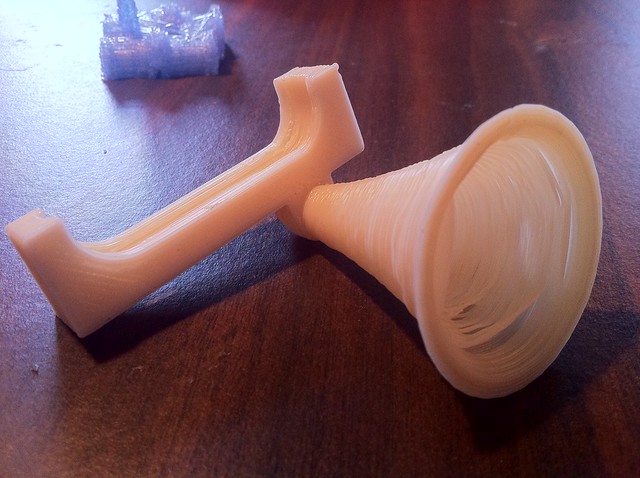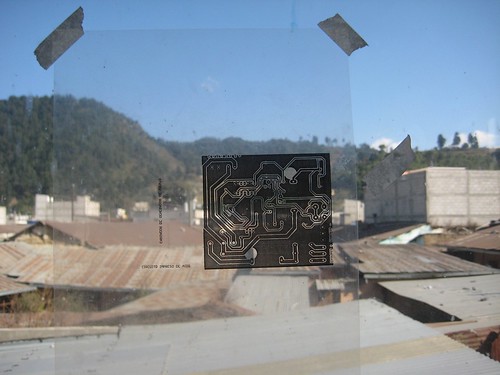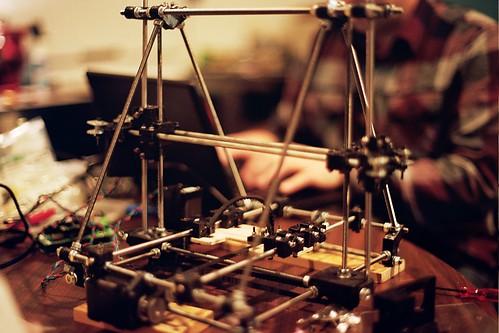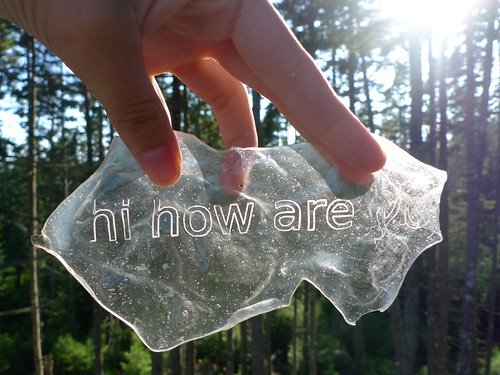We have a sewing machine? Well almost. It needs a belt and some needles, but by the time you need it, it will be working.

JUSTSAYIN
Phonecone: designed and printed at Hive76
I saw this design and decided to make my own. You can make your own from thingiverse.
Here’s a video of it from robot_trouble:
February 9th Open House Recap
Well I got there a bit late, as I also attended the second ever PhillySec meeting earlier that night. So when I finally got to Hive there were already a lot of interesting things going on. I noticed Sean McBeth working on a contraption that he revealed to be an Atari Punk Console (which he later finished that night), Jordan Miller printing away on his newly completed RepRap, and Brendan Schrader and PJ Santoro doing some music in the back of the room. Brendan had an Electribe with him (having previously engineered new features in to), and PJ was tinkering with some Linux-based karaoke software.
Yes, thanks to PJ’s karaoke software, Brendan’s audio mixer, and one of Chris Thompson’s (and Brendan’s) BOOMcases we indeed had an impromptu karaoke session. Yours truly sang “Folsom Prison Blues” by Johnny Cash, and “Maneater” by Hall & Oates; which I must say was my first time doing karaoke. Eventually the night ended after we did a modest set of about 7 or 8 songs. It was a blast, and something that we may well do again in the future.
Next Wednesday we’re hosting another game night. We’ll be bringing back Artemis Spaceship Bridge Simulator for a second round.
Hope to see you there!
February Robotics Meetup Group Wrap-Up
Last night Hive 76 hosted the second Robotics Meetup Group of the year. We saw some new faces and discussed some interesting topics such as beginner robotics kits, Arduino-based robotics solutions, oscilloscopes, and wirelessly powered flying robots.
Speaking of flying robots, regular member Tom Setliff brought in his quadrotor (a robot which uses 4 rotors for flight) project that he’s been working on for about 2 months now. It really surprised us how far along he’s already gotten with the frame for his creation. Kudos Tom. Our organizer and group leader Roy Brewer also talked about the custom made AVR-based microcontroller that he’s testing out for his own quadrotor project.
The video here, sent in by Hive 76 member Jim Fisher (also of PLUG and PACS fame), shows a proof of concept Quadrotor demo being done at GRASP Labs at the University of Pennsylvania.
Our very own Hive 76 Quartermaster, Brendan Schrader had some cool things to say in our conversation about oscilloscopes. He even showed us his neat Seed Studio pocket oscilloscope.
All together another great meeting for 2011!
For those that are interested, our next meeting is March 10th at 7:30 PM. Hope to see you there next month!
Appropriate tech in Guatemala: AIDG biodigester

This past winter, I spent a month in Guatemala studying Spanish, checking out appropriate technology projects, and zipping around the geologically manic country around the Western Highlands. Here’s a reportback from a visit to the offices of the Appropriate Infrastructure Development Group (AIDG). I got to check out some prototype wind and solar designs and take a peek at their new kit-built CNC machine and custom circuit board designs. Later, I got to poke around the office and come along on a site visit to a biodigestor installation they did outside of the city. It lets the farmers nearby turn animal waste into organic fertilizer and cooking gas while reducing greenhouse emissions. I got to hear about the combination of technical and user friendliness challenges they encountered and saw how the system is working now that it’s been tweaked a few times. Pretty cool stuff.
How I Became A Maker
Growing up, my dad worked overseas for the State Department so we moved all over the Middle East.  I always wanted to know how everything worked, and my dad had a hint of an interest in electronics and other hobbies, but resources were always a little limited and there weren’t any skilled mentors I could learn as much as I wanted from. I recall spending a lot of time coming up with wacky invention ideas, most of which in hindsight are probably infeasible, but coming up with the ideas was always half the fun anyway. My dad would bring home articles from magazines on topics he thought I’d find interesting, like building simple robots, or making red jello lasers. Periodically I would get an inkling to try realizing one of my inventions and I would save up my allowance money, eventually putting together an order from a surplus catalog in the States. It would take 2 weeks for my snail-mail order to arrive there through the diplomatic pouch, and another 2 weeks to receive my parts, and as you can imagine of a young kid, I usually ended up getting bored with waiting and abandoned the original idea for something I could do much sooner. I had a great set of books, a silver hard-bound set called “How Things Work”, which was wonderful for fueling the inner mad scientist in me. In about 4th grade I remember spending a fair bit of time designing the space ship that I hoped would eventually rescue me from homework and school, and also allow me to explore and perhaps begin colonizing Titan, one of the moons of Saturn. (Needless to say, that one hasn’t panned out. Yet.)
I always wanted to know how everything worked, and my dad had a hint of an interest in electronics and other hobbies, but resources were always a little limited and there weren’t any skilled mentors I could learn as much as I wanted from. I recall spending a lot of time coming up with wacky invention ideas, most of which in hindsight are probably infeasible, but coming up with the ideas was always half the fun anyway. My dad would bring home articles from magazines on topics he thought I’d find interesting, like building simple robots, or making red jello lasers. Periodically I would get an inkling to try realizing one of my inventions and I would save up my allowance money, eventually putting together an order from a surplus catalog in the States. It would take 2 weeks for my snail-mail order to arrive there through the diplomatic pouch, and another 2 weeks to receive my parts, and as you can imagine of a young kid, I usually ended up getting bored with waiting and abandoned the original idea for something I could do much sooner. I had a great set of books, a silver hard-bound set called “How Things Work”, which was wonderful for fueling the inner mad scientist in me. In about 4th grade I remember spending a fair bit of time designing the space ship that I hoped would eventually rescue me from homework and school, and also allow me to explore and perhaps begin colonizing Titan, one of the moons of Saturn. (Needless to say, that one hasn’t panned out. Yet.)
I really had an interest in how almost everything worked, picking up as many things as I could. One day my dad brought home the first Magic Eye picture I’d ever seen, and after struggling with it for an hour it was an incredible feeling when the image of the earth finally popped out at me in all its 3D splendor, and I’d been bitten by the 3D bug. Living where I did, we didn’t have access to hardware stores or Radio Shack, but there were petrified forests, ripe with geodes and other marvels of geology that I loved to learn about. In slightly later years I learned some interesting things about chemistry, and am probably fairly lucky to have all of my fingers and toes. After figuring out how to make a surprisingly effective blowgun with quite nasty darts, I got a taste of what fun working with projectiles can be, going on in much later years to build a high-power rocket that is fired from a pneumatic cannon.
I was always interested in computers, and had a burning desire to learn how to write my own software. In elementary school I stumbled onto HyperCard (an incredible thing at the time), and I was off and running teaching myself some basics of algorithms, and writing simple tools and games. (I was never particularly interested in actually playing games, much preferring to explore and learn, or take things apart and dream of what I could do with the pieces.) Discovering programming was a bit of a boon for me, because it was a way of inventing for free — no materials to buy or wait for in the mail, no tools to wear out, if I could dream it and if I had the motivation, I could make it happen for nothing. From that point on I think I just assumed that I would go on to major in Computer Science when I got old enough. Little did I know that when that time came, I would abandon it after feeling like the educational system was beating all the fun out of it for me.
I’ve always found myself wanting to understand things, but having to teach myself. While that has been frustrating, usually taking much longer than simply being taught by an expert, I think it has been valuable for shaping how I approach challenges. Making things can be a puzzle, an adventure, or a game, and it’s so much more rewarding in the end than something you’ve bought or watched on TV.
SloateBot: Prusa Mendel Lives!
The Prusa Mendel build is finally complete! Here’s a Stanford Bunny:
Prusa Mendel Bunny Print by jmil
PLA bushing sliding on precision ground 8 mm rods is actually quite smooth movement. I don’t think it can go as fast as the original Sells Mendel (which was ball bearings sliding over the rods), but it’s only half the printed parts and the z-axis is much smoother motion too. I will try oiling or greasing the bushings to try to get smoother and faster motion without losing steps. So definitely some tradeoffs but overall a super awesome bot. The Prusa is also fully parametric and entirely made from OpenSCAD. All sources are available on github FTW.
As this is the first bot I built that I actually own, I named this awesometown after my HS science teacher, Mr. Sloate, who really got me into Biology and now, robotics for Biology.
What will we print next?
Open House Wednesday: Bioplastic & LEDs
This Wednesday Mike and I will make some bioplastic from starch, water, glycerin, and vinegar. Then microwave it, squish it in a mold, and stick some LEDs in there. If you haven’t noticed, I like doing things for the sake of doing them and then maybe finding a use.
There will also be some blink & buzz supplies there and heart shaped molds for your people that care about hearts.
♥♥♥♥♥♥
Gitmarks 2.0 Alpha
As rumors of delicio.us shutdown rumbled through the internet, a bunch of geeks in a minor IRC channel started gabbing. They has a lot of info, links, tags, and data stored in delico.us, and were afraid to lose them, syncing, and all other good features. They realized as geeks often do, that if we owned the service, we wouldn’t have to worry about outside shutdowns if we had our own service. Thus hypatia spun-up Federated Bookmarks
The first output of this crew is something called gitmarks, based on work by Hillary Mason (of bit.ly). This is a little tool to store bookmarks, bookmark metadata, and page content locally for searching, using, and peer-to-peer sharing. Since it is based on git this system can use a central server, *or* it can share peer to peer. As the name implies, it uses a git backed for data transfer and versioning. It also has the ability to pull down content for a local cache, and for local searching.
This project is in Alpha, and if you want to test the silly thing, the basics work. If you want to help build a cool distributed tool, we could use some help! We need to building a server, building more git tools, xmmp messaging, and browser integration. We also hope to create tools that along the way that make it easy to build systems for Moglen Boxen. Ping FarMcKon@gmail.com, leave a comment here, or hit #hive76 in IRC if you want to help.
Hive76 Celebrates the Birth of Our Third 3D Printer!

Back in 2009, we ordered our first 3D printer, the MakerBot Cupcake. Since then, we’ve become pros at fixing, modifying, and mostly breaking it. We’ve even created new, awesome products for it which have been adopted by a good portion of the 3D printing community, and even sold by MakerBot themselves.
Shortly after completing our Makerbot, once-member fynflood decided to start building the RepRap Mendel, which is the 2nd generation of the RepRap Project’s 3D printer. He started by printing all of the pieces on our MakerBot, which took over 20 hours to complete, and gathered all of the required hardware with help from many of our members. A printer was born out of Hive76, and life was good. A few months later, there was a post on the reprap aggregation pipe about a new iteration of the reprap, called the Mendel Mini (now the RepRap Huxley), which has a similar build volume to the MakerBot, but can be assembled for under half the cost. Fynflood set out to print the parts on his Mendel, while I gathered all the required hardware and electronics. After a few months break over the summer, and a few more months being busy with the Holidays, the Huxley is now complete! Our printer’s baby made a baby!
At this very moment, we have 2 MakerBots and the Huxley all going at the same time at the space! If any more printers show up, we’ll probably have to start giving away USB Typewriters just to make room! Really, it’s an exciting time to be printing at Hive76, so if you have any interest in learning how 3D printers work, or even building your own, come by for open house on Wednesdays and check out all the awesome things we’re making!
Hit the jump for a few videos and images from the first few prints!
Continue reading “Hive76 Celebrates the Birth of Our Third 3D Printer!”


